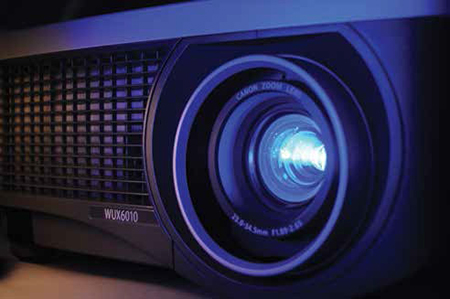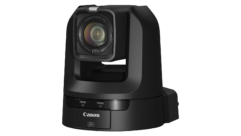

When it comes to installing projectors, we have a rather large array of options from which to choose. So, what make one better than another? Better stated, what are the features and functions that make one projector better suited to our application than another? Of the major considerations, resolution and brightness are certainly at the top of the list. But each installation has a set of requirements and it is our job to select the projector that fits best with the needs of the application. So, if you are looking to provision a space that requires a larger screen, then you need to look to the larger, brighter projectors that are specifically designed for installations. One of the strong contenders is the Canon Realis WUX6010, which I was able to put thorough the paces in my shop.
THE BASICS
From the ground up, this is a projector aimed squarely at installation. It has a three-chip LCoS engine that provides a full 6000 Lumen output, and has a native 16:10 aspect ratio that provides a true 1920×1200 (WUXGA) resolution. While this projector is not compact, Canon has done a very nice job of fitting the engine into a reasonably sized case that weighs in at about 19 lbs. (officially 18.73 lbs.). And, since we are always concerned about noise, the WUX6010 is almost as quiet as many of the smaller compact projectors. At full output, I confirmed only 40dB of fan noise.
In Power Saver mode, the WUX6010 provides a bright image of over 4600 Lumens and I measured 36dB of fan noise. That means that, in power saver mode, it produces less noise and a brighter image than many smaller projectors. While we’re talking about Power Saver mode, the lamp life extends from 3000 hours up to 4000 hours. In addition, the power consumption drops from a reported 465 watts down to only 370 watts.
Input connections on the WUX6010 include two analog ports, one VGA (and component video) within the DVI-I connector and a second VGA DB15 connector. There are three digital input connections, one HDMI, one within the DVI-I connector and an HDBaseT connection. Further, with the use of software from Canon, the WUX6010 includes the ability to display over the network. Finally, you can connect a USB storage device and playback JPEG files without the use of a computer.
INCLUDED FEATURES
The Canon Realis WUX6010 has been designed from the ground up to be installed and integrated into an AV room solution. Beyond the higher light output, the WUX6010 has features that really are useful when it comes to installations. So, let’s take a look at the features of this projector that makes it a very good option for an installation.
Lensing: Canon is known for high quality lenses for their cameras and they use that knowledge to create their projector lenses. This is important because as much as 50% of the light provided by the projector can be lost in the optics of the lens. Not so for Canon. These lenses are crafted to allow as much of the light to reach the screen as possible.

Table 1
As with many projectors in the installation class, this one does not come with a lens. You must select the right lens for your application. Officially you can buy the projector and the standard zoom lens as a package, but you will still have to install the lens yourself. To make it a little easier to compare the lenses, I have arranged the five options in a table from widest to longest. There are a couple of important things to note about these lenses. First, Canon publishes the F-number for each of the optional lenses. This allows us to actually calculate the light that will arrive at the screen. Second, there are no gaps between the zoom lenses. This assures that we can place the projector where it needs to be. If you have ever had to adjust the projector mounting position to avoid an architectural feature or an obstacle, you can bet that the gap in lens throw-distance will always be right where you need to place the projector.
In the case of the WUX6010, virtually all of the lens controls are powered and they are included in presets that can be stored and recalled. The powered control of the lens includes zoom, focus and both vertical and horizontal lens shift. To some this may seem to be a luxury, but when it comes to managing a projector that is mounted in a high ceiling, or in a location that has limited access, powered control can be a significant asset.
Color Management: Color accuracy can be a very important consideration when selecting a projector for an installation. First, this is an LCoS Liquid Crystal on Silicon) technology based projector. As a reminder, there are three technology options available (LCD, DLP and LCoS) in projectors today and each has its own color profile that can be quite distinctive. You have a decision to make about what is important to the content type and environmental factors of your particular application and whether you need to prioritize accuracy, richness, contrast, lack of artifacting, temporal performance, a film-like aesthetic, etc..
Regardless of underlying technology, when integrating a projector into a system, it can be critical to adjust the color management within the projector to compensate for differing conditions and most particularly for the variations in sources. As with other functions in the WUX6010, the color management system allows the choices to be set and recalled.

The folks at Canon have given this projector an incredible range of color control from basic range options to detailed control that includes six-axis control for those applications where fine color control is critical to the use of the display. The WUX6010 includes seven image modes and five user definable modes. The benefit of these is in the ability to match the color control to the source and the ambient lighting conditions in the room where the projector will be used.
Canon offers two versions of this projector, the standard WUX6010 (the one I got from Canon to review) and a version that has a DICOM simulation mode. I have mentioned DICOM simulation before, but it may be beneficial to provide an explanation of what this means. DICOM (Digital Imaging and Communications in Medicine) is a standard used to display monochrome images from X ray radiography, CT images, MRI images, etc. Canon provides a version of several projectors, including the WUX6010D, that simulate this standard. This is very helpful in some lecture and academic conference applications, but it must be made very clear that this is only a simulation mode. The WUX6010 cannot be used for radiological image reading or medical examinations.

Sound system: When it comes to large space integration, there is a reasonable assumption that the room is too big to be properly supported by the amplifier and speakers in the projector. That said, Canon has provided the WUX6010 with a sound system. However it is a single speaker that is supported by a relatively small 5watt amplifier. I found the combination to be respectable in performance, and sufficient to be heard in a small room.
Network Connectivity: Canon has provided for control and management of the projector with the expected RS232 port, but it also includes network connectivity. In the case of the WUX6010, there is an RJ45 network connector and the HDBaseT connection also allows for IP control. This may seem redundant, but it is an important feature. The example is that the computer in the room may need to be able to control the projector via the Canon Networked Multi-Projection (NMPJ) software and the projector may need to be connected to the network for room resource management or device security.
Control: When you are considering a projector for installation, you should look for features that make the installation time shorter. In the case of the WUX6010, Canon has embedded both Crestron and AMX protocols into the WUX6010 to ease the effort of programming the control system for the features of the display.
Software: With the WUX6010 connected to a network, you can share content from one or more computers running the NMPJ software from Canon. This software is only available for the Microsoft Windows operating systems, but it is quite powerful. NMPJ allows for sharing from multiple projectors. One scenario allows you to show as many as four computers on a single projector screen. The software also allows you to choose between the primary display and the extended display from a laptop. For more on the NMPJ software see the Canon website.
To wrap things up, there are a lot of projectors that are aimed at the installation market. When considering a projector for a permanent installation, you need to do some research. Make sure that you match the features to the application. What I think you will find is that the Canon Realis WUX6010 is a feature-rich projector well suited to many installation applications. It produces a bright 6000 Lumen image and has the lensing options that make it a serious contender. Finally, the Canon Realis WUX6010 brings the color accuracy that has come to be expected from LCoS technology.
PRODUCT SUMMARY
COMPANY: Canon, http://www.usa.canon.com/internet/portal/us/home/products/details/projectors/all-projectors/wux6010
PRODUCT: Canon Realis WUX6010 projector
PROS: High brightness, color accuracy, extensive adjustments, five interchangeable lenses
CONS: Larger frame size; lenses sold separately
APPLICATIONS: Installed projection for classrooms, training rooms, conference rooms and other medium sized venues
PRICE: $5499 MSRP each (no lens)
SPECIFICATIONS
6000 LUMEN
WUXGA (1920X1200)
THROW RATIO: 1.49 – 2.21:1, f/1.9 – f/2.7
INPUT CONNECTIVITY: DVI-I (VGA and Digital), VGA, HDMI, HDBaseT and USB (Flash Drive)
NETWORK CONNECTIVITY: Wired LAN connection and through the HDBaseT connector
LENS SHIFT V: -15% to +55%, H: ±10%
FAN NOISE: 40dB (at full light output)
UNIT WEIGHT: 18.73lbs.
DIMENSIONS: 14.96in. x 6.69in. x 16.92in.










